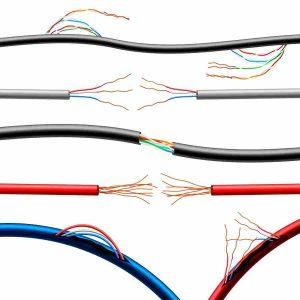In the digital age, where data is king and cybersecurity threats loom large, safeguarding your business has never been more critical. While investing in advanced security software and robust firewalls is essential, many overlook the foundational element that ties everything together: network cabling. In this insightful exploration, we delve into how network cabling pays a pivotal role in enhancing your business’s overall security infrastructure.
1. Reliability and Resilience
Network cabling forms the backbone of your business’s communication infrastructure, enabling seamless connectivity between devices, servers, and systems. A well-designed and properly installed cabling network ensures reliable data transmission, minimizing the risk of communication failures or downtime.
By investing in high-quality network cabling solutions, such as Category 6 (Cat6) or fiber optic cables, you can enhance the resilience of your network infrastructure. These cables offer greater bandwidth, faster data transfer speeds, and increased immunity to electromagnetic interference, ensuring uninterrupted operation even in the face of external disruptions or cyberattacks.
Furthermore, the reliability of your cabling directly impacts the performance of critical security systems such as surveillance cameras, access control devices, and intrusion detection sensors. By minimizing signal attenuation, data loss, and transmission errors, robust it ensures that security-related data is transmitted accurately and promptly, enabling timely detection and response to potential threats.
2. Physical Security For Network Cabling
In addition to protecting against digital threats, it also contributes to physical security measures within your business premises. Properly installed cabling infrastructure helps to organize and secure network cables, reducing the risk of tripping hazards, cable damage, or unauthorized access.
By implementing cable management practices such as cable trays, conduits, and enclosures, you can maintain a tidy and organized cabling environment while safeguarding against tampering or sabotage. This not only enhances workplace safety but also mitigates the risk of accidental disruptions to your network connectivity.
Moreover, strategically positioned network cables can serve as a physical barrier to unauthorized access, especially in sensitive areas where strict access controls are required. By routing cables through secure pathways and locking down access points, you can prevent unauthorized individuals from tampering with or compromising your network infrastructure, thus bolstering overall security.
3. Surveillance Integration
Network cabling serves as the backbone for integrated surveillance systems, enabling seamless connectivity between security cameras, recording devices, and monitoring stations. By deploying Power over Ethernet (PoE) technology, which delivers power and data over a single cable, you can simplify the installation and management of surveillance cameras while reducing wiring complexity.
A well-designed surveillance infrastructure, powered by robust network cabling, enhances your business’s security posture by providing real-time monitoring, incident detection, and forensic analysis capabilities. With strategically positioned cameras and reliable network connectivity, you can deter unauthorized access, detect security breaches, and respond swiftly to potential threats.
Furthermore, advanced and it’s solutions such as fiber optics offer extended transmission distances and immunity to electromagnetic interference, making them ideal for deploying surveillance cameras in challenging environments such as outdoor areas or industrial facilities.
By leveraging the versatility and reliability of fiber optic cabling, you can extend the reach of your surveillance network and enhance situational awareness across your business premises.
Also Read:- 6 Importance of Fibre Optic Cable Installation in Modern Networks
4. Access Control
It also plays a crucial role in facilitating access control systems, which regulate entry to sensitive areas within your business premises. By integrating access control devices such as card readers, biometric scanners, and electronic locks with your network infrastructure, you can establish granular access policies and enforce stringent security measures.
Securely encrypted communication channels, facilitated by robust ensure that access control data remains protected from interception or manipulation. This enables you to authenticate users, monitor access attempts, and log entry events in real-time, enhancing overall security and compliance with regulatory requirements.
Moreover, networked access control systems offer centralized management capabilities, allowing administrators to configure access permissions, update user credentials, and generate audit reports from a single interface. By leveraging the scalability and flexibility of networked access control solutions, you can adapt to changing security requirements and mitigate the risk of unauthorized access or insider threats effectively.
5. Scalability and Future-Proofing of Network Cabling
Investing in a scalable and future-proof it infrastructure enables your business to adapt and expand in response to evolving security needs and technological advancements. By choosing cabling solutions that support higher data transfer speeds and greater bandwidth, you can accommodate the increasing demands of emerging technologies such as cloud computing, IoT (Internet of Things), and AI-driven analytics.
Moreover, a well-designed cabling infrastructure simplifies the integration of new security devices and systems, allowing you to seamlessly incorporate advanced security features and capabilities as your business grows. This proactive approach to infrastructure planning ensures that your security investments remain effective and relevant in the long term.
Conclusion
It is not merely a mundane aspect of IT infrastructure but a foundational element that underpins your business’s overall security posture. By investing in high-quality network cabling solutions, implementing robust cable management practices, and leveraging the versatility of networked security systems, you can safeguard your business against a wide range of physical and digital threats. As technology continues to evolve, embracing the critical role of network cabling in enhancing security infrastructure is essential for ensuring the resilience and longevity of your business operations.




